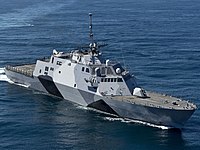
Photo from wikipedia
Abstract The motion and added resistance of flexible ships are numerically analyzed using a fluid–structure interaction model. To analyze the interaction model, whole domain is split up into two domains:… Click to show full abstract
Abstract The motion and added resistance of flexible ships are numerically analyzed using a fluid–structure interaction model. To analyze the interaction model, whole domain is split up into two domains: the fluid and structural domains. The fluid domain is analyzed using a Rankine panel method (RPM) and the structural domain is analyzed using finite element method (FEM). Two domains are coupled using eigenvectors. The added resistance of rigid and flexible ships are computed using two formulas: a direct pressure integration formulation and a momentum conservation formulation. The direct pressure integration formulation of the rigid ship is extended to the flexible ship. The blunt modified Wigley model is selected as a test model. The motion of the flexible ship is compared with the motion of a rigid ship, and the change in motion response is examined. The added resistance of the flexible ship obtained from the two numerical formulations is compared, and the results agreed well. In order to identify the effect on a real ship, the presented formulation is applied to a 18,000 TEU container ship. The flexible deformation and change in added resistance of this ship are small. Compared to a rigid body, a slight decrease of added resistance is observed if wavelength and ship length are similar.
Journal Title: Journal of Fluids and Structures
Year Published: 2019
Link to full text (if available)
Share on Social Media: Sign Up to like & get
recommendations!